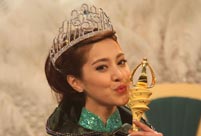 Cockfighting show staged in E. China's Heze during Spring Festival
Cockfighting show staged in E. China's Heze during Spring Festival
 Chinese New Year Flower Fair opens in San Francisco
Chinese New Year Flower Fair opens in San Francisco
 Festivities in Shanghai
Festivities in Shanghai
 PLA navy conducts drill in North China Sea
PLA navy conducts drill in North China Sea
 World's high-tech hotels
World's high-tech hotels
 Li Na poses with trophy on Brighton Beach in Melbourne
Li Na poses with trophy on Brighton Beach in Melbourne
 Six Chinese divers back safely after 300-meter saturation dive
Six Chinese divers back safely after 300-meter saturation dive
 Traditional wedding ceremony of Yao people
Traditional wedding ceremony of Yao people
 Taipei Game Show attracts geeky gamers
Taipei Game Show attracts geeky gamers
Different emphasis
While the tale of Pegasus is not widely known in China, "flying horse" is by no means a strange term. Several brands are named after it, most notably a cigarette with a long history.
It is true that China may pale in comparison with the West in creating talking horses or weeping horses in art and literature, with most of our horse-related prominence being in our vocabulary.
But before we get to that, I'll point to the different emphasis, or rather East-West focus, on different aspects of the horse. For example, most English words for "horse" define the animal by age and gender, such as colt for a male horse under the age of 4, filly for a female horse less than 4 years old, mare for a female aged 4 or older, yearling for one between 1 and 2 years old, and foal for one younger than a year old. Gelding and stallion denote castration or non-castration.
In contrast, most Chinese descriptions for the horse concern colors. Biao (骠) is yellow; liu (骝) is red with black mane and tail; yan (骃) is grayish; li (骊) is black; guo (騧) is yellow with black mouth; qi (骐) is purplish black; hua (骅) is red like the fruit date; xing (骍) is another kind of red; cong (骢) is blue; zhui (骓) is black with white feet; and mang (駹) is black with white face. Ju (驹) and ji (骥) refer to young and old horses, but not how young or how old, while jun (骏) and nu (驽) are names for fast and slow ones.
We have more names for different horses than there are zodiac animals, but most of them appear to have been inspired by the color spectrum.
We Chinese also have an equivalent for the term "prince charming" that has a whiff of the fairytale about it. It is "prince on a white horse" or "white-horse prince".
But a study of the colors of horses' coats made me realize the inherent irony in this Disney-like phrase: With rare exceptions, a horse turns gray or white as it ages, and is usually born with a darker shade. If you are not sure, check the skin underneath a white horse's coat.
So, associating a prince with mortality is not really the best way to present his youthful charm. However, since most of us are not equine veterinarians, we can be excused for envisioning this most desirable companion for females in the color of purity and forget about old age.


 3D film 'The Monkey King' premieres in Beijing
3D film 'The Monkey King' premieres in Beijing  Miss Chinese Int'l Pageant 2014 held in Hong Kong
Miss Chinese Int'l Pageant 2014 held in Hong Kong 'Golden Flowers' in the Spring Festival travel rush
'Golden Flowers' in the Spring Festival travel rush Li Na beats Cibulkova to win Australian Open
Li Na beats Cibulkova to win Australian Open Sexy models at Taipei Game Show 2014
Sexy models at Taipei Game Show 2014 'Living in ice house' competition held in central China
'Living in ice house' competition held in central China  Highlights of Chinese airborne troops'exercises
Highlights of Chinese airborne troops'exercises  All-male high speed train crew during Spring Festival travel rush
All-male high speed train crew during Spring Festival travel rush PLA navy drills in East China Sea
PLA navy drills in East China Sea President Xi visits border troops ahead of Lunar New Year
President Xi visits border troops ahead of Lunar New Year What do Chinese pack in their luggage in Spring Festival Rush?
What do Chinese pack in their luggage in Spring Festival Rush? Blind date fair in Hangzhou of Zhejiang province
Blind date fair in Hangzhou of Zhejiang province Film 'Where Are We Going, Dad' premiered in Beijing
Film 'Where Are We Going, Dad' premiered in Beijing  Australian Open champion Li Na returns to hometown Wuhan
Australian Open champion Li Na returns to hometown Wuhan Twin sisters serve during Spring Festival travel rush for the first time
Twin sisters serve during Spring Festival travel rush for the first timeDay|Week|Month